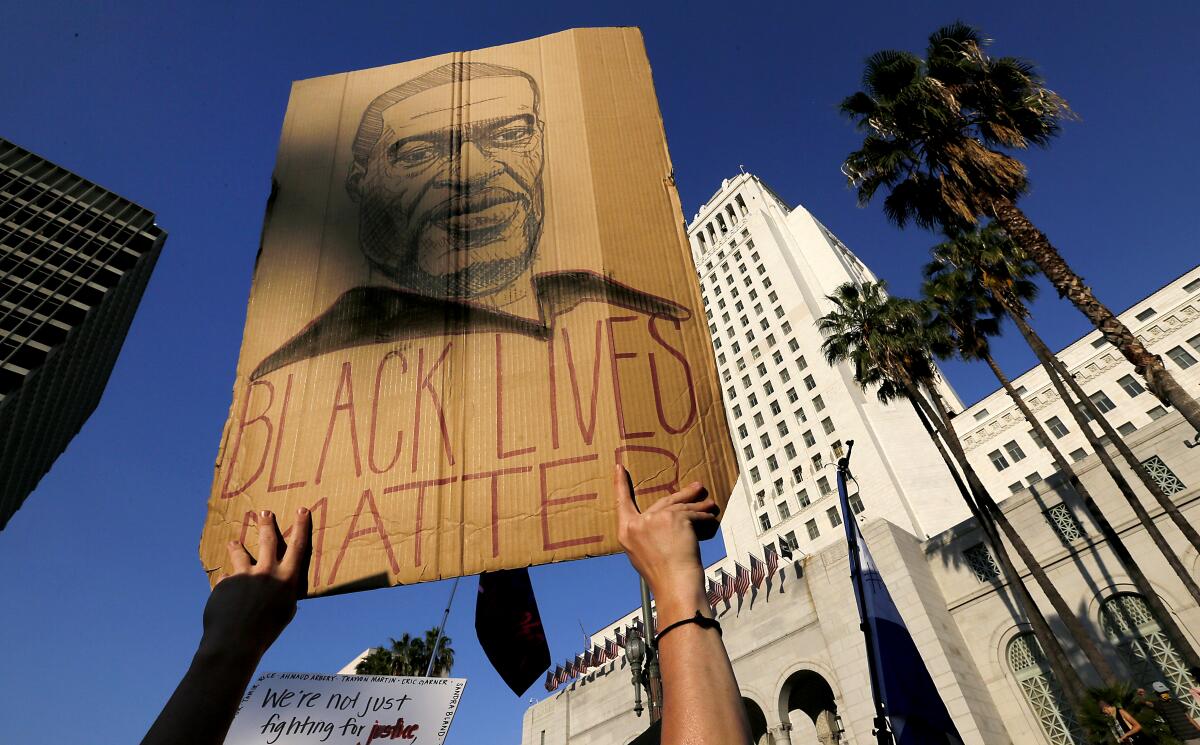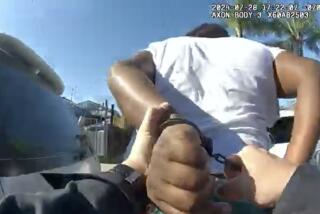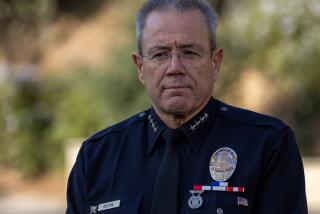Police agencies are banning a controversial neck hold after George Floyd’s death

- Share via
Law enforcement agencies and elected officials across the country moved quickly this week to ban officers from using a controversial neck hold, responding to nationwide outrage over the killing of George Floyd by a Minneapolis police officer who knelt on his neck for more than eight minutes.
Gov. Gavin Newsom and members of the California Legislature’s black and Latino caucuses called for a statewide ban on carotid holds, which involve putting pressure on the sides of a person’s neck to restrict blood flow.
The move followed widespread protests that prompted more than a dozen law enforcement agencies in California — including the San Diego police and sheriff’s departments — to announce in recent days that they would stop officers from using carotid neck restraints.
“We all witnessed this execution,” said Assemblyman Mike Gipson (D-Carson), the lead author of a bill introduced Friday that would ban the use of the holds throughout California. “This was far beyond the existing law that authorizes a peace officer to use reasonable force to effect the arrest, to prevent escape or to overcome resistance.”
The carotid restraint technique taught to police involves an officer using an arm and is markedly different from the video-recorded actions of the Minneapolis police officer charged with murder in Floyd’s death. But the image of the 46-year-old black man losing consciousness with an officer’s knee pressed into his neck has generated renewed criticism of police tactics such as the carotid hold.
The city of Minneapolis agreed Friday to ban the use of all chokeholds, including neck restraints, as part of a settlement with the Minnesota Department of Human Rights.
The carotid restraint, also known as a sleeper hold or a blood choke, has a troubled history.
The Los Angeles Police Commission severely restricted its use in 1982 after the deaths of a dozen black men and then-LAPD Chief Daryl Gates’ notorious comment that African Americans were dying because the “veins or arteries of blacks do not open up as fast as they do in normal people.”
Other law enforcement agencies, however, continued to allow the holds with fewer restrictions.
A Times analysis of California Department of Justice data found that law enforcement around the state reported officers seriously injuring 103 people while using carotid neck restraints from 2016 through 2018, the most recent years for which data are available.
Two people were killed and 91 were left unconscious. Black people, who compose about 6.5% of California’s population, made up 23% of people injured by neck restraints. White people accounted for 33% of the incidents and Latinos 38%.
The analysis counted incidents in which carotid holds were listed in the data as the most severe type of force used.
The San Diego County Sheriff’s Department led the state with 21 carotid restraints that resulted in serious injury, according to The Times’ data analysis.
“In light of community concerns and after consultation with many elected officials throughout the country, I am stopping the use of the carotid restraint by my deputies effective immediately,” San Diego County Sheriff Bill Gore said in a statement on Wednesday.
San Diego’s city police had resisted calls to ban carotid holds as recently as last year, saying the technique was used safely hundreds of times and can help end potentially dangerous encounters quickly before they escalate.
But Police Chief David Nisleit said this week that he would stop the use of the neck holds immediately.
Police departments in Santa Cruz, Watsonville, Oceanside, Coronado and La Mesa have announced similar bans. In Sacramento, Mayor Darrell Steinberg has called for a review on whether to ban the controversial restraint.
Shane Harris, president of the advocacy group the People’s Alliance for Justice, said local departments made the “morally right” decision to halt use of the “dangerous” carotid hold.
“We can no longer use this kind of restraint to cut off the artery at any length anymore,” Harris said. “But I think that we have a lot more work to do on reforming sheriff and police departments across the state of California. I think that we’re at a turning point in America, where we’re going to go one way toward progress or go the other way toward regress.”
Los Angeles County Supervisors Janice Hahn and Mark Ridley-Thomas have introduced a motion urging the Sheriff’s Department and 46 police agencies in the county to reform their use-of-force policies, including by restricting or prohibiting the use of carotid holds, chokeholds and strangleholds. The motion will be discussed Tuesday at the Board of Supervisors’ meeting.
When employing a carotid hold, an officer puts pressure on the carotid arteries to slow or block blood flow. If applied correctly, the person can fall unconscious. But it can also lead to injury or death.
In 2016, a Bakersfield police officer used a carotid hold to subdue 63-year-old Jose Cesar Vilorio, who later died from blunt-force trauma and a neck compression due to the hold, according to a coroner’s report.
Vilorio had reportedly threatened his girlfriend with a machete that day. Officer Timothy McIrvin responded to Vilorio’s apartment, saw the man was armed and applied a carotid hold on him for 10 to 15 seconds until he lost consciousness, according to departmental review of the incident. Another officer soon realized Vilorio was not breathing and performed CPR until paramedics arrived. Vilorio died at a hospital the next day.
McIrvin’s use of the carotid hold was deemed within department policy, according to a report from the agency’s Critical Incident Review Board.
Bakersfield Police Sgt. Nathan McCauley said this week that the department is reviewing its policy on the carotid hold and its effectiveness. The department’s website shows officers employed the hold 22 times from 2016 through 2018.
Some law enforcement officers have long argued the dangers of using the carotid hold are overblown and defend the technique as safe if used properly. They say that banning it altogether could result in officers resorting to more dangerous methods to subdue a resisting suspect, such as using batons or firearms.
According to The Times’ analysis of statewide data, officers were assaulted in 74% of the carotid incidents reported to the state. In 94% of all incidents, the person restrained was unarmed.
Ed Obayashi, a Plumas County sheriff’s deputy and use-of-force advisor to the California Assn. of Police Training Officers, said police departments for years have shifted away from using the carotid technique, which is different from a chokehold in which pressure is applied to the windpipe.
“The whole point is to render someone unconscious and not cut off their airway, but it could potentially result in that,” Obayashi said. “You still have your arm around someone’s neck.”
The overall number of carotid restraints resulting in serious injury is low considering the millions of police interactions that occur each year in California, he said. Officers are trained how to use other options, such as Tasers or pepper spray.
Obayashi said many deputies patrol rural areas without a partner and need to be able to use a carotid neck restraint if they feel their lives are in danger.
“I know cases where deputies have had to fight for their lives and they were by themselves. We won’t take away that option from them given the solitary nature of policing in these counties,” he said.
In the Minneapolis case, Officer Derek Chauvin used his knee to apply pressure to Floyd’s neck for more than eight minutes. As Floyd lay on the ground, he pleaded, “I can’t breathe.” His words echoed the last pleas of Eric Garner, an unarmed black man who was killed in 2014 when a New York police officer placed him in a chokehold.
Chauvin has been charged with second-degree murder, and three other Minneapolis officers have been charged with lesser offenses.
Robert Weisberg, a professor at Stanford Law School, said there is now “unquestionably a serious public perception problem” regarding the use of neck holds, but he stressed that the technique used by Minneapolis police is not in line with what officers in California are trained to do.
“It was a damn knee on the guy’s neck,” Weisberg said. “It was really just a sadistic way of keeping him on the ground.”
The state justice department requires agencies to report only cases in which carotid holds resulted in serious injury or death. In Los Angeles County, the Long Beach Police Department led all agencies with 12 reported incidents during the three-year period, according to the state data. Riverside police reported 17 incidents and San Bernardino police logged six.
The L.A. County Sheriff’s Department reported two incidents that resulted in serious injury and the Los Angeles Police Department one incident, the data show.
Sheriff’s Lt. John Satterfield said his department’s policy classifies carotid holds as a high-risk technique. Since 2010, deputies have used the hold 193 times with no deaths, he said.
Neck holds have long been banned or restricted by the LAPD. In 1982, Gates, the chief, banned the bar-arm chokehold, in which an officer uses his forearm to apply pressure directly against the windpipe, after a 24-year-old black motorist sued in an effort to forbid the move.
Weeks later, the city’s Police Commission voted to limit the use of the carotid hold after the death of James Mincey Jr., a 20-year-old black man who was put in a carotid hold after leading officers on a high-speed car chase. His death was the 16th over seven years that was attributed to the carotid restraint, The Times reported in 1993 when the City Council agreed to pay a $450,000 settlement to Mincey’s father.
The LAPD still allows officers to use a carotid restraint, but restricts it to situations where deadly force is justified. The technique is seldom used, LAPD records show. It has been used a total of seven times since 2015, according to the department’s 2019 use-of-force report.
Times staff writer Patrick McGreevy and Teri Figueroa of the San Diego Union-Tribune contributed to this report.
More to Read
Sign up for Essential California
The most important California stories and recommendations in your inbox every morning.
You may occasionally receive promotional content from the Los Angeles Times.











